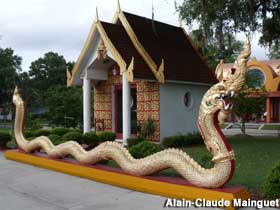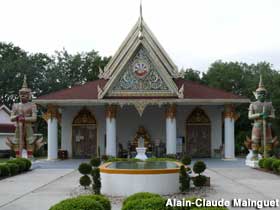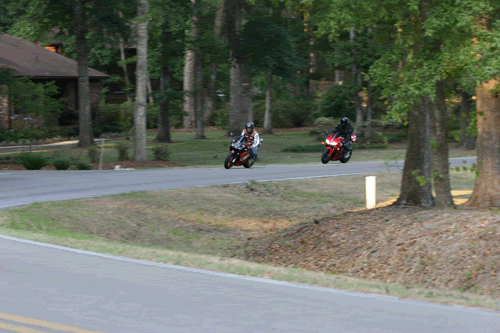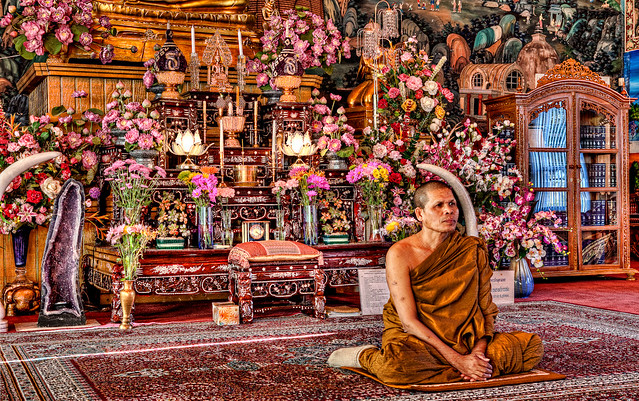
TIPITAKA AND TWELVE DIVISIONS
Brief historical background
Sutta Pitaka
Vinaya Pitaka
Abhidhamma Pitaka
Twelve Divisions of Buddhist Canons
Nine Divisions of Buddhist Canons
TIPITAKA AND TWELVE DIVISIONS is the collection of the teachings of the Buddha over 45 years. It consists of Sutta (the conventional teaching), Vinaya (Disciplinary code) and Abhidhamma (commentaries).
The Tipitaka was compiled and arranged in its present form by the disciples who had immediate contact with Shakyamuni Buddha.
The Buddha had passed away, but the sublime Dhamma which he unreservedly bequeathed to humanity still exists in its pristine purity.
Although the Buddha had left no written records of his teachings, his distinguished disciples preserved them by committing to memory and transmitting them orally from generation to generation.
Brief historical background
Immediately after the final passing away of the Buddha, 500 distinguished Arahats held a convention known as the First Buddhist Council to rehearse the Doctrine taught by the Buddha. Venerable Ananda, who was a faithful attendant of the Buddha and had the special privilege of hearing all the discourses the Buddha ever uttered, recited the Sutta, whilst the Venerable Upali recited the Vinaya, the rules of conduct for the Sangha. One hundred years after the First Buddhist Council, some disciples saw the need to change certain minor rules. The orthodox Bhikkus said that nothing should be changed while the others insisted on modifying some disciplinary rules (Vinaya). Finally, the formation of different schools of Buddhism germinated after his council. And in the Second Council, only matters pertaining to the Vinaya were discussed and no controversy about the Dhamma was reported. In the 3rd Century B.C. during the time of Emperor Asoka, the Third Council was held to discuss the differences of opinion held by the Sangha community. At this Council the differences were not confined to the Vinaya but were also connected with the Dhamma. The Abhidhamma Pitaka was discussed and included at this Council. The Council which was held in Sri Lanka in 80 B.C. is known as the 4th Council under the patronage of the pious King Vattagamini Abbaya. It was at this time in Sri Lanka that the Tipitaka was first committed to writing in Pali language.
The Sutta Pitaka consists mainly of discourses delivered by the Buddha himself on various occasions. There were also a few discourses delivered by some of his distinguished disciples (e.g. Sariputta, Ananda, Moggallana) included in it. It is like a book of prescriptions, as the sermons embodied therein were expounded to suit the different occasions and the temperaments of various persons. There may be seemingly contradictory statements, but they should not be misconstrued as they were opportunely uttered by the Buddha to suit a particular purpose.
This Pitaka is divided into five Nikayas or collections, viz.:-
Dlgha Nikaya (Collection of Long Discourses)
Majjhima Nikaya (Collection of Middle-length Discourses)
Samyuita Nikaya (Collection of Kindred Sayings)
Anguttara Nikaya (Collection of Discourses arranged in accordance with number)
Khuddaka Nikaya (Smaller Collection)
The fifth is subdivided into fifteen books:-
Khuddaka Patha (Shorter Texts)
Dhammapada (The Way of Truth)
Udana (Heartfelt sayings or Paeons of Joy)
Iti Vuttaka (’Thus said’ Discourses)
Sutta Nipata (Collected Discourses)
Vimana Vatthu (Stories of Celestial Mansions)
Peta Vatthu (Stories of Petas)
Theragatha (Psalms of the Brethren)
Therigatha (Psalms of the Sisters)
Jataka (Birth Stories)
Niddesa (Expositions)
Patisambhida (Analytical Knowledge)
Apadana (Lives of Saints)
Buddhavamsa (The History of Buddha)
Cariya Pitaka (Modes of Conduct)
Vinaya Pitaka The Vinaya Pitaka mainly deals with the rules and regulations of the Order of monks (Bhikhus) and nuns (Bhikhunis). It also gives an account of the life and ministry of the Buddha. Indirectly it reveals some useful information about ancient history, Indian customs, arts, sciences, etc. For nearly twenty years since his enlightenment, the Buddha did not lay down rules for the control of the Sangha. Later, as the occasion arose, the Buddha promulgated rules for the future discipline of the Sangha. This Pitaka consists of the following five books:-
Parajika Pali (Major Offences)
Pacittiya Pali (Minor Offences)
Mahavagga Pali (Greater Section)
Cullavagga Pali (Smaller Section)
Parivara Pali (Epitome of the Vinaya)
Abhidhamma Pitaka The Abhidhamma, is the most important and interesting, as it contains the profound philosophy of the Buddha’s teaching in contrast to the illuminating but simpler discourses in the Sutta Pitaka. In the Sutta Pitaka one often finds references to individual, being, etc., but in the Abhidhamma, instead of such conventional terms, we meet with ultimate terms, such as aggregates, mind, matter etc. In the Abhidhamma everything is analyzed and explained in detail, and as such it is called analytical doctrine (Vibhajja Vada). Four ultimate things (Paramattha) are enumerated in the Abhidhamma. They are Citta (Consciousness), Cetasika (Mental concomitants). Rupa (Matter) and Nibbana. The so-called being is microscopically analyzed and its component parts are minutely described. Finally the ultimate goal and the method to achieve it is explained with all necessary details. The Abhidhamma Pitaka is composed of the following works:
Dhamma-Sangani (Enumeration of Phenomena)
Vibhanaga (The Book of the Treatises)
Ikatha Vatthu (Point of Controversy)
Puggala Pannatti (Description of Individuals)
Dhatu Katha (Discussion with reference to Elements)
Yamaka (The Book of Pairs)
Patthana (The Book of Relations)
Twelve Divisions of Buddhist Canons The content of Buddhist canons is divided into twelve divisions, categorized by the types of forms of literature (i.e., Sutta, Geyya and Gatha) and the context (i.e., all other nine divisions). It is known as the Twelve Divisions.
Sutta - These are the short, medium, and long discourses expounded by the Buddha on various occasions. The whole Vinaya Pitaka is also included in this respect.
Geyya - i.e., the metrical pieces. These are discourses/proses mixed with Gathas or verses.
Gatha - i.e., verses, chants or poems. These include verses formed in the Dharmapada, etc., and those isolated verses which are not classified amongst the Sutta.
Nidana - i.e., the causes and conditions of the Buddha’s teachings.
Itivrttaka - i.e., the suttas in which the Buddhas tell of the deeds of their disciples and others in previous lives.
Jataka - i.e., stories of the former lives of Buddhas. These are the 547 birth-stories.
Abbhuta-dhamma - i.e., miracles, etc. These are the few discourses that deal with wonderful and inconceivable powers of the Buddhas.
Avadana - i.e., parables, metaphors. Illustrations are used to facilitate the human beings to understand the profound meanings of the Buddhist Dhamma.
Upadesa - i.e., dogmatic treatises. The discourse and discussions by questions and answers regarding the Buddhist doctrines. It is a synonym for Abhidhamma Pitaka.
Udana - i.e., impromptu or unsolicited addresses. The Buddha speaks voluntarily and not in reply to questions or appeals, e.g., the Amitabha Sutta.
Vaipulya - i.e., interpretation by elaboration or deeper explanation of the doctrines. It is the broad school or wider teachings, in contrast with the “narrow” school. The term covers the whole of the specifically Mahayana suttas. The Suttas are also known as the scriptures of measureless meaning, i.e., infinite and universalistic.
Veyyakarama - i.e. prophecies, prediction by the Buddha of the future attainment of Buddhahood by his disciples.
Nine Divisions of Buddhist Canons
The term is generally referred to Hinayana. There are only nine divisions excluding Udana, Vaipulya and Veyyakarana.
However, there is also a Mahayana division of nine of the Twelve Divisions, i.e., all except Nidana, Avadana and Upadesa. Dhammapada Verse 242-Annatarakulaputta Vatthu-Ignorance Is The Greatest Taint-Verse 243. Ignorance The Worst Taint
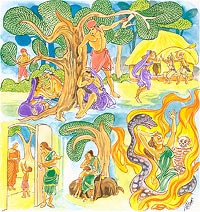
Verse 242. Ignorance Is The Greatest Taint
In mankind, conduct culpable,
with givers, avariciousness,
all blemishes these evil things
in this world or the next.
Explanation: For mankind, misconduct is the blemish. For charitable
persons, miserliness is the stain. Evil actions are a blemish both
here and in the here-after.
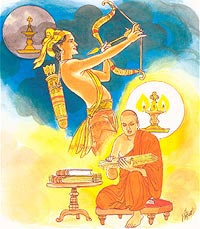
Verse 243. Ignorance The Worst Taint
More basic than these blemishes
is ignorance, the worst of all.
Abandoning this blemish then,
be free of blemish, monks!
Explanation: Monks, there is a worst blemish than all these
stains. The worst stain is ignorance. Getting rid of this stain become
stainless.
Dhammapada Verses 242 and 243
Annatarakulaputta VatthuMalitthiya duccaritam
maccheram dadato malam
mala ve papaka dhamma
asmim loke paramhi ca.Tato mala malataram
avijja paramam malam
etam malam pahantvana
nimmala hotha bhikkhavo.Verse 242: Sexual misconduct is the taint of a woman; stinginess is the taint
of a giver; evil ways are indeed taints in this world as well as in the next.Verse 243: A taint worse than these is ignorance (of the Truth), which is the
greatest of taints. O bhikkhus, abandon this taint and be taintless.
The Story of a Man Whose Wife Committed Adultery
While residing at the Veluvana monastery, the Buddha uttered Verses (242) and
(243) of this book, with reference to a man whose wife committed adultery.Once, the wife of a man committed adultery. He was so ashamed on account of
his wife’s misbehaviour that he dared not face anyone; he also kept away from
the Buddha. After some time, he went to the Buddha and the Buddha asked him why
he had been absent all that time and he explained everything. On learning the
reason for his absence, the Buddha said, “My disciple, women are just
like a river, or a road, or a liquor shop or a rest house, or a water-pot stand
at the roadside; they associate with all sorts of people. Indeed, sexual
misconduct is the cause of ruin for a woman.”Then the Buddha spoke in verse as follows:
Verse 242: Sexual misconduct is the taint of a
woman; stinginess is the taint of a giver; evil ways are indeed taints
in this world as well as in the next.Verse 243: A taint worse than these is ignorance
(of the Truth), which is the greatest of taints. O bhikkhus, abandon
this taint and be taintless.
At the end of the discourse many people attained Sotapatti Fruition.
AWAKEN ONE WITH AWARENESS ONLINE GOOD NEWS LETTER
ALL ABOUT USA
Florida
• Guang Ming temple, OrlandoGuang Ming Temple
佛光山光明寺
enomination Linji Ch’an / Humanistic Buddhism Founded 2007 Founder(s) Hsing Yun Abbot(s) Ven. Chueh Fan Address 6555 Hoffner Road, Orlando, FL 32822 Country United States Website www.orlandobuddhism.org/ The Guang Ming temple (Chinese: 光明寺; pinyin: Guāngmíng Sì; Pe̍h-ōe-jī: Kong-bîng-sī; literally “Bright Light Temple”) in Orlando, Florida, United States is the largest Buddhist temple in Central Florida. The three story, 30,000 square feet (2,800 m2), traditional Chinese-monastic style temple was completed in 2007 and cost approximately $5 million dollars to construct. The temple is associated with Fo Guang Shan, a monastic organization from Taiwan led by Venerable Hsing Yun that claims over 1 million members worldwide, and with Hsi Lai Temple in Los Angeles. Guang Ming is home to several resident monastics,
and boasts a vast main shrine room, auxiliary meditation room,
vegetarian cafeteria, tea room, gift shop, and guest dormitories. The
temple is open daily from 10:30 am to 5:00 pm, and weekly events are
held in Chinese as well as English.
• Tubten Kunga CenterTubten Kunga Center
Tubten Kunga Center (TKC), is a Buddhist Center in Deerfield Beach, Florida. TKC follows the Gelugpa tradition of Tibetan Buddhism, which is the lineage of the Dalai Lama. The center offers classes on meditation and Buddhist philosophy, under the direction of resident teacher Geshe Konchog Kyab.
Tubten Kunga Center is located at 201 SE 15th Terrace, Suite 211, Deerfield Beach, Florida 3341.
• Wat Florida DhammaramWat Florida Dhammaram
Orlando’s best free Buddhist theme park
Wat Florida Dhammaram (website) is a Buddhist monastery in Kissimmee, Florida (map),
where tourists, attracted by the colorful Thai architecture, sometimes
stop to ask if it is a theme park. While the Wat (monastery) is a
functioning spiritual community of monks and supportive laypeople, it
is the Orlando area’s best Buddhist theme park. And, it is free.
Before there were tourists, of course, there were pilgrims, and
pilgrimage is an ancient part of Buddhist practice. You can access a
free full-length book (pdf) on Buddhist Pilgrimage (right click to save).The Buddha
himself taught that there were four places associated with events in
his life which a pilgrim might visit. Temples have been built at each of
those four sites, and at Wat Florida Dhammaram you can make a little
pilgrimage to replicas of each of those four temples, and they have
pictures of these shrines on their website (here).
Since the four shrines are associated with four events in the life of
the Buddha, this Buddhist theme park is a good starting point for
learning about the Buddha. You can learn more in A Sketch of the Buddha’s Life.
Lubini
Prince Siddhartha, as he should be called before he attained Enlightenment, was born in Lubini.
The shrine at Wat Florida is built in commemoration of his birth,
although it is not a copy of a specific building. His mother, Queen
Maya, is seen, standing and holding a tree branch (the way she is
traditionally shown giving birth), and the infant is also standing,
again following tradition that he stood and walked as soon as he was
born.
Bodgaya
The second shrine is a replica of the temple at Bodgaya, where the Buddha sat and attained enlightenment.
Sarnath
The third shrine is a replica of the stupa (monument) at Sarnath. This site is important because here the Buddha preached his first sermon, “Setting Rolling the Wheel of Truth”
(click to read the sermon) to his first five followers, who became the
first monks, and so, the sangha or monastic community was founded. The
five companions are shown at the shrine listening to the teacher.
Kusinara
Finally, there is the the temple at Kusinara, which commemorates the parinibbana or death of the Buddha at the age of eighty. The word parinibbana (or parinirvana) refers to the state into which the Buddha, who had already attained nibbana (nirvana) entered at death. The Buddha in parinibbana is represented reclining, as is traditional. There is an ancient teaching,” Last Days of the Buddha,” which provides the story of the parinibbana of the Buddha, as well as a summary of his teachings, including instructions to visit these four sites of pilgrimage.
So, tourists who stop and ask if Wat Florida Dhammaram is a theme park
have a great opportunity to change from tourists, always looking for a
new sensation, to pilgrims, always seeking spiritual attainment.
Buddhists walking through the immaculately maintained grounds have a
chance to reflect upon the life of the great teacher, and those who are
not Buddhists have a chance to feel and experience the presence of a
Buddhist community reaching back to the time of the great teacher
himself.Wat Florida Dhammaram (Thai: วัดฟลอริดาธรรมมาราม) is a Buddhist monastery in Kissimmee, Florida, established by Lung-po Chaokhun Phra Tepvaraporn
(Im Arindhamo) in the mid-1990s. Over a decade ago, Lung-po visited
lay-devotees in Florida and perceived the lack of a Buddhist monastery
in the Central Florida area. With approval from the late abbot of Wat Sommanat Vihara, Chaokhun Somdej Phra Wannarat Chop Thitadhammamahathera, he began fund raising in Thailand. In 1993, three monks were sent with Prakrupalad Sunnan (now Chaokhun Phra Vijitrdhammapani, the present abbot) to establish and further the development of Wat Florida Dhammaram.
Buddhist Temple Tour This
garden is so quiet that it inspires meditation. Temples, pagodas, and
chapels are numerous, with the ubiquitous presence of Buddha. [Alain-Claude Mainguet, 05/05/2011]
Wat Florida Dhammaram
Today we took a “field trip” to Wat Florida Dhammaram, a
Thai Buddhist temple located in Kissimmee. We met this really nice
monk, Than Chokun Sunan, who didn’t mind posing for a few photos for
us and telling us all about the temple. It’s not the largest temple
but they have a bunch of great monuments that are begging to be
photographed.
• Wat Lao Buddha Phavanaram, Kenneth CityKenneth City, Florida
Kenneth City, Florida — Town — Location in Pinellas County and the state of Florida
Coordinates: 27°48′58″N 82°42′55″WCoordinates: 27°48′58″N 82°42′55″W Country United States
State Florida
County Pinellas Area • Total 0.7 sq mi (1.9 km2) • Land 0.7 sq mi (1.9 km2) • Water 0 sq mi (0 km2) Elevation 20 ft (6 m) Population (2010) • Total 4,980 • Density 7,100/sq mi (2,600/km2) Time zone Eastern (EST) (UTC-5) • Summer (DST) EDT (UTC-4) ZIP code 33709 Area code(s) 727 FIPS code 12-36175[1] GNIS feature ID 0294454[2] Kenneth City is a town in southern Pinellas County, Florida, between St. Petersburg and Pinellas Park, in the United States. Kenneth City was founded in 1957 by Sidney Colen, a local developer, who named the city after his son Kenneth Colen.[3][4] The population was 4,980 at the 2010 census.[5]
The town, small in area and set amidst dense residential developments
mostly with otherwise indistinguishable town boundaries, has earned a
reputation as a speed trap town for the vigorous enforcement of its
lower speed limits.[6]Families at The Breakers

VOICE OF SARVAJAN



